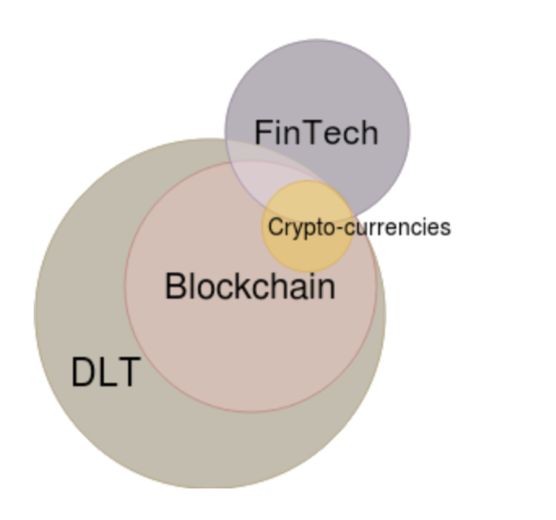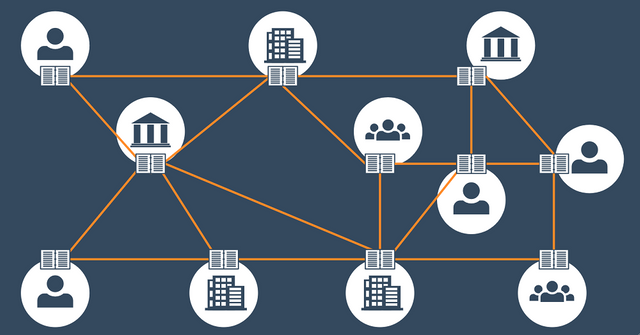DLT, Blockchain, and Cryptocurrencies: What it all Means for FinTech and More
Intro
It is clear that there exists great market confusion about what is the distinction between different terminologies that keep flotation around the ecosystem. Most people cannot tell apart Bitcoin and Ethereum or the difference between a Blockchain and a cryptocurrency, and most importantly, all blockchain based research and solutions are just assumed to be directly under the huge scope of FinTech.
Let us hope the distinction between each is soon cleared so that all the false promises and ill-informed market “experts” can divert their focus towards better understanding the prospects that the ecosystem can promise.
Distributed Ledger Technologies (DLT)
Let me clear the biggest question around: Yes, Blockchain is a Distributed Ledger Technology. But to be fair, Distributed technologies have been around way before blockchain or bitcoin was even conceived. In its roots, DLT is a shared database that is synchronized periodically to maintain a copy of records around a distributed network of nodes. DLT mechanisms were readily researched and implemented since the 1990s. What it lacked was a fool-proof consensus mechanism that proved the legitimacy of nodes on a peer-to-peer network, across a wide geographical area that ensures the disincentive to provide duplicate and false records to the distributed network. The Bitcoin blockchain became the most famous form of DLT mechanism since it was introduced in 2009, that solved the problem of consensus and paved the way for a whole new range of applications that fall under the DLT sphere.
After the invention of a Blockchain, several organizations and consortiums such as R3, Hyperledger, EEA etc., began to explore around the concept of a “Private Blockchain”, a distributed database that doesn’t require data to be propagated to every user, but can be delegated to a set of pre-specified trusted actors than guarantee the authenticity of the data. Some people think that the concept of a “Private Blockchain” is an oxymoron because privatization strips Blockchain of all the essential features that distinguished it from a traditional distributed database. Thus, Corda, Hyperledger and the likes come under the wide scope of Distributed Ledger Technology and not the Blockchain.
Blockchain
Blockchain is a subset of DLT. Blockchains are basically a distributed database that includes consensus and verification mechanisms to provide authenticity across the network, which maintain its difference from a traditional DLT. Since 2009, thousands if not millions of use cases have been developed with the concept of Blockchain at its center. Several different mechanisms of Blockchains that differ from the original Bitcoin blockchain have also been developed that best suit the needs of the case at hand. The first consensus mechanism was the Proof-of-work (PoW) that uplifted bitcoin to be the most widely used Blockchain based cryptocurrency, as it provides consensus through staking energy. Since then mechanisms such as Proof-of-stake (PoS), Delegated Proof-of-Stake (dPoS), Integrated Pow + PoS, Federated Byzantine Fault Tolerance (FBFT) etc., have been developed, tailored according to the needs of the specified blockchain they are built upon.
Blockchain has a wide scope as it forms the base layer for other sophisticated application to be built upon, some of them being
- Decentralized Market place
- Digital reputation based identity
- Smart Contracts and Ricardian Contracts
- Cryptocurrencies
- Distributed applications
- Governance models
- Medical advancements
Cryptocurrencies
Cryptocurrencies are an added, non-mandatory application that forms a sub-set of Blockchains. A cryptocurrency is a cryptographically-secured digital currency that is stored and transacted through a base layer blockchain. Often times, both Blockchain and cryptocurrencies are perceived to be synonymous, one and the same, but that is not usually the case. Though cryptocurrencies provide and determine the value of their base layer Blockchains, they are not the most integral part of the Blockchain. It is possible for a Blockchain to function with issuing its own cryptocurrency, just like it is possible for a company to function without issuing shares. A cryptocurrency is merely a mediating vehicle for functioning with the blockchain. If a blockchain does not want to issue a native currency, it can store value and transact in another cryptocurrency. It is also possible to issue many cryptocurrencies from the same base layer blockchain to deal in a variety of applications. For eg: The Ethereum blockchain, through its ERC-20 and other features allows for communities and organizations to issue their own cryptocurrency that is cryptographically linked to the base layer blockchain, and is also different from the native currency of Ethereum, Ether.
Cryptocurrencies can be used for speculation and profit-making, which is the sole reason by which both Blockchain and Cryptocurrencies are regarded as FinTech innovations, even though Blockchains based applications are proved to function on a much wider scope.
FinTech
FinTech usually refers to the mechanism by which technological medium such as computers and mobile applications are used to enable banking and other related financial services. The FinTech technology innovations usually cover financial services such as, automation of insurance; trading of securities, shares, bonds, and assets by digital means; managing risk through algorithmic trading and hedging etc. As Blockchains and cryptocurrencies are currently associated with easing the use of financial services and a means of a store of value, they are generally regarded as a FinTech innovation, for which reason, Blockchain applications are generally developed to be FinTech specific. But in recent times, Blockchains have shown their potential to affect sectors far greater than the scope of financial services, as mentioned above.
Conclusion
It is important for the market to realize the distinguishing features that separate and intersect Distributed ledgers, Blockchain, cryptocurrencies, and FinTech. Yes, blockchain and distributed ledgers can perform innovative functions for the FinTech sector and bring advancements in automation, transparency, registration and reduce friction, but it can do the same and maybe more for advancing Law, Medicine, Business, Governance, distributed applications or any model that needs third party intermediation for functioning.
Sources
1. Distributer Ledger Technology - Wikipedia
2. Four applications for Blockchains other than cryptocurrencies
3. Financial Technology - Wikipedia
Image Sources
1. Blockchain - Thomas Reuters
2. FinTech - TheNextWeb
3. DLT - Gov.uk
------
ReverseAcid Monthly Recap
-------
Crypto Analysis Series
- Part 1 - Basic Attention Token and How It's Revolutionizing the Internet
- Part 2 - Golem Network Token as a Potential Giant Killer
- Part 3 - Augur and the Future of Decentralized Predictions Markets
- Part 4 - Dogecoin - Such Meme, Much Value
--------
Previous posts:
- Confidence Crisis: HODL on to Your Horses
- Bitcoin Technicals: In Depth Breakdown of the Current Move
- The Scalability Trilemma
- Online Retailer’s Incentives for using cryptocurrencies as a medium of exchange
- Bearish Sentiment is Almost Gone: Bitcoin Technical Breakdown - 21 November 2018
-------
About Reverse Acid
-------
Be a part of our Discord community to engage in related topic conversation.




)
Congratulations @reverseacid! You have completed the following achievement on the Steem blockchain and have been rewarded with new badge(s) :
Click here to view your Board of Honor
If you no longer want to receive notifications, reply to this comment with the word
STOPTo support your work, I also upvoted your post!